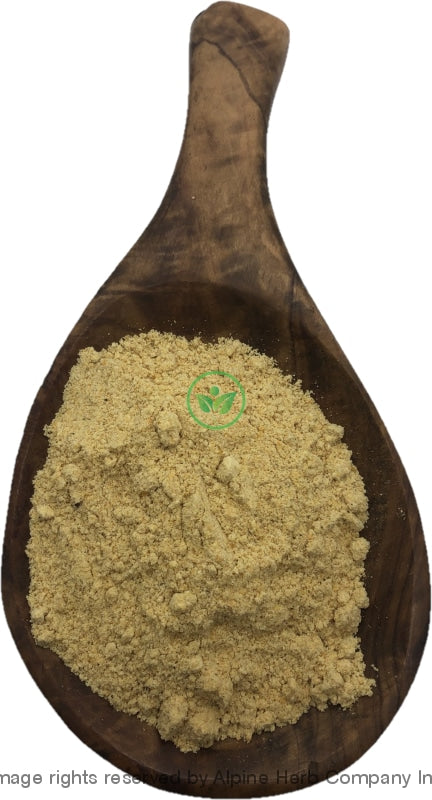Mustard Seed Powder – Yellow Alpine Herb Company Inc.
$ 4,99 $ 2,99
Botanical Name: Sinapis alba
Common Name:
- English: White mustard, Yellow mustard
- Ayurvedic: Siddhaartha, Shveta, Sarshapa, Sarshapa-Gaura
- Unani: Khardal Safed
- Also, known as: Venkadugu, Safed rai, Dholi rai, Raydo, Moutarde blanche, Echter senf, Moutarde blanche
Habitat: Native of Europe and West Asia. Cultivated in North India as a crop.
Origin: Canada
Harvested: Cultivated
Parts Used: Seed
General Information:
Yellow mustard seed is also known as white mustard. The White Mustard, a native of Europe, common in our fields and by roadsides, and also largely cultivated, is an erect annual, about a foot or more in height, with pin-natifid leaves and large, yellow, cruciferous flowers. It closely resembles the Black Mustard but is smaller. The fruit of the two plants differs considerably in shape, those of the White Mustard being more or less horizontal and hairy, while Black Mustard pods are erect and smooth. The pods of White Mustard are spreading, roundish pods, ribbed and swollen where the seeds are situated, and provided with a very large flattened, sword shaped beak at the end. Each pod contains four to six globular seeds, about u inch in diameter, yellow both on the surface and internally. The seed-coat, though appearing smooth, on examination with a lens, is seen to be covered with minute pits and to be finely reticulated. The inner seed coats contain a quantity of mucilage, with which the seeds become coated when soaked in water, hence they are often employed to absorb the last traces of moisture in bottles which are not chemically dry. The cotyledons of the seeds contain oil and give a pungent but inodorous emulsion when rubbed with water.
How to use:
Powdered Herb:
There are different ways to use powdered herb.
Food Preparation: You can add powdered herb to any super food herbal smoothie, sauces, spreads and even cookies. Also for children, you can mix powdered herb with honey or glycerin to make paste. The thicker the paste, the more potent and herbal in taste. The sweet taste of honey and glycerin will help medicine go down. This method is also known as “Electuaries”.
Capsules: Encapsulating your own powdered herb at home, gives you assurance that the contents of the capsules are pure herb and no filler or any other products. These capsules can be taken with liquid.
Poultice: Poultice can be made with an herbal powder and liquid (mostly water) to form a paste which is then applied to the skin. This method is very helpful for skin conditions.
Herbal shot: Powdered herb can be mixed with water, fruit juice or other liquid to make herbal shot.
Precautions:
You should consult with a qualified healthcare practitioner before using any herbal products, particularly if you are pregnant, nursing, or on any medications.
All information on this website is for educational purpose ONLY
This information has not been evaluated by Health Canada.
This information is not intended to diagnose, treat, cure, or prevent any disease.
| Unit Size | 100g, 200g, 400g, 1kg |
|---|
Prompt shipping and expert packing
Thanks to our longstanding association with UPS FedEx DHL as well as other leading global carriers, we can offer a variety shipping options. Our warehouse staff is highly trained and will be able to pack your goods in accordance with our precise and exact specifications. Your items will go through an exhaustive examination before they will be securely packaged before being delivered. We ship to hundreds of thousands of customers daily in different countries. This is a sign of our determination to become the largest online retailer worldwide. Warehouses and distribution centers are located throughout Europe as well as in the USA.
Note that orders containing multiple items are processed according to the particular item.
We will thoroughly inspect all items ordered before shipping. Most orders are shipped within 48 hours. The delivery time will be between 3 and 7 working days.
Returns
The stock market is always changing. It's not entirely managed by us since we're involved with several entities, including the factory and the storage. Therefore, the actual inventory could fluctuate at any moment. Please be aware that it is possible that your order could be out of stock after you've placed your order.
Our policy lasts for 30 days. If it's been more than 30 days since the date you purchased your item We're sorry to say that we can't offer you a full exchange or refund.
You can only return a product if it is unused and still in the same state as when you received it. The item should be in the original packaging.
Related products
Spices Powder
Spices Powder
Spices Powder
Spices Powder
Spices Powder
Spices Powder
Spices Powder
Spices Powder
Spices Powder
Spices Powder
Spices Powder
Spices Powder
Spices Powder
Spices Powder
Spices Powder
Spices Powder
Spices Powder
Spices Powder
Spices Powder
Spices Powder
Spices Powder
Spices Powder
Spices Powder
Herb Powder
Spices Powder
Spices Powder
Spices Powder
Spices Powder
Spices Powder
Spices Powder


































